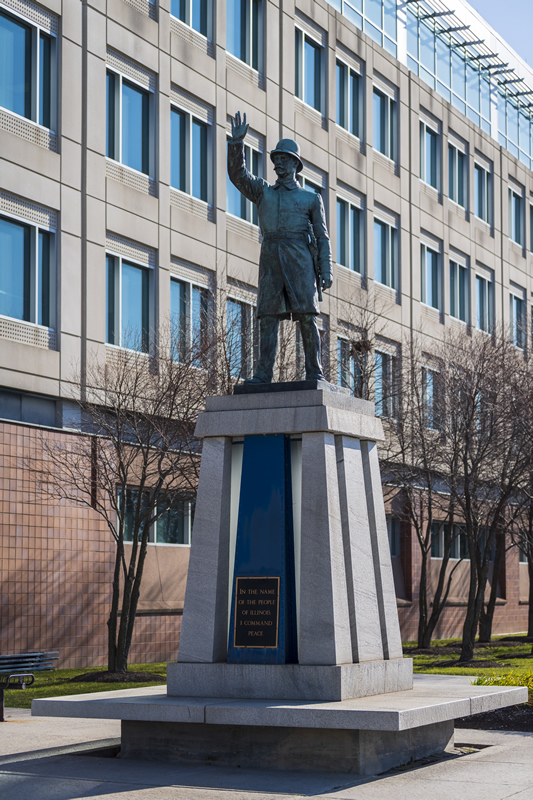Chicago Police Department Headquarters
Public Art Program > Chicago Police Department Headquarters
3510 S. Michigan Ave.
Chicago, IL. 60653
Madder Gorget
Frank Connet
2001, Shibori on fabric, Three sections, H 4 ft. x W 10 ft. (each)
City of Chicago Public Art Collection
Frank Connet used a technique of sewn resist, Shibori, to create the imagery for Madder Gorget. Hundreds of hand-sewn stitches make up an individual shape. The stitches are then pulled taut, resulting in a uniform surface that resists dye. After the dye is applied to the fabric, the stitches are removed and the image appears. The Shibori technique has been used for thousands of years by Asian, African and Native American cultures.
Location: Records Room
 Four Generations of African-American Quilt Makers
Four Generations of African-American Quilt Makers
Gladys Henry, Laverne Brackens, Sherry Byrd and Bara Byrd
Mixed materials, Four quilts: H 89 in. x W 84 in., H 87 in. x W 88 in., H 80 in. x W 85 in., H 88 in. x W 81 in.
City of Chicago Public Art Collection
Quilts symbolize warmth, comfort, home and tradition. Quilting is a craft traditionally handed down from mother to daughter. Often, quilters will add their own improvised embellishments to the family’s traditional designs. The women who created these quilts represent four generations of an African American family established in East Texas.
Location: 1st Floor, Outside Media Room
 Meridian VII
Meridian VII
Ed McCullough
2002, Stainless steel, H 13 ft. x W 14 ft.
City of Chicago Public Art Collection
Ed McCullough’s Meridian VII delineates and activates this space intended for human interaction. Steel arcs and planes define a place for employees to sit and break from their routines. The sculpture’s raised planes beckon the viewer to enter and become part of the artwork. Its horizontal surfaces function as steps and seating, and diagonal elements, as back rests.
Location: Outdoor Courtyard
 Chicago in Four Seasons
Chicago in Four Seasons
Joe Hindley
2002, Oil on canvas, Two murals, H 14 ft. x W 60 ft. (each)
City of Chicago Public Art Collection
Joe Hindley’s Chicago in Four Seasons consists of two pieces entitled North Side in Spring and Summer and South Side in Fall and Winter. These paintings portray familiar and idealized scenes of community life, including architecture, unique to Chicago’s North Side and South Side neighborhoods. North Side in Spring and Summer depicts a police officer responding to a minor traffic accident, while neighbors maintain and beautify the community. A blindfolded woman at center, holding a scale and standing on the waves of Lake Michigan, is the allegorical figure of Justice. South Side in Fall and Winter portrays indoor activities sheltered from the cold and snow. To the left, a pianist and violinist perform a duet. On the right, a family spends a leisurely day together indoors. The central images—a scientist looking through a microscope, and a man turning an enormous wheel representing science and industry—pay tribute to the great industrial boom that figured so prominently in Chicago’s history.
Location: Main Lobby
 Haymarket Monument
Haymarket Monument
Mike Baur
2007, Bronze, glass, granite, H 20 ft.
City of Chicago Public Art Collection
John Gelert’s restored 1889 sculpture, the Haymarket Monument rests upon a new pedestal by Chicago sculptor Mike Baur. The nation’s first monument to fallen police officers, Gelert’s sculpture was precipitated by the deadly riot during a Near West Side labor rally on May 4, 1886. A bomb thrown into the crowd killed four civilians and eight Chicago Police Department officers—the single largest loss of life in the line of duty, from a single incident, in the department’s history. Baur’s pedestal design rejuvenates the classical 19th-century bronze and complements this 21st-century facility’s modern architecture. At nearly 11 feet high, the pyramid-shaped pedestal’s broad base represents the citizens, whose support is needed for effective community policing. Eight supporting columns represent the officers killed. Inscribed on a seven-foot-tall bronze plaque are the words of Captain Ward spoken moments before the 1886 explosion, “In the name of the people of the State of Illinois, I command peace.”
Location: Outside, West Entrance

